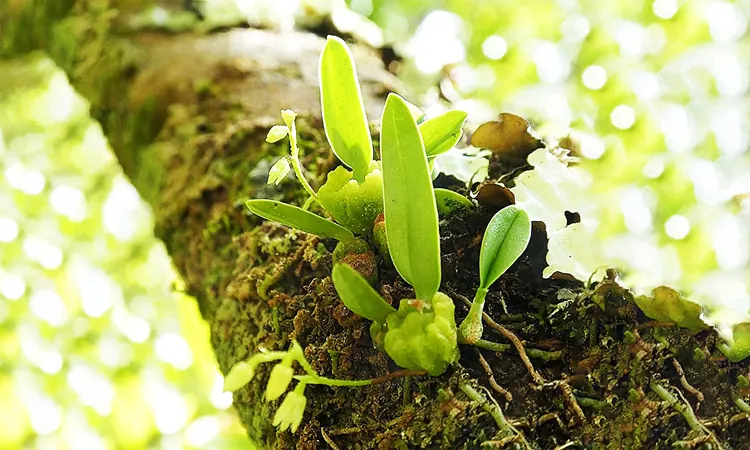
Exciting New Orchid Species Found on Norfolk Island: A Botanical Marvel Resembling a Cupcake!
2025-01-15
Author: Rajesh
The Discovery Journey
During a field expedition, Dr. Heidi Zimmer, an esteemed orchid researcher at the Australian National Herbarium (ANH), alongside fellow botanist Dr. Mark Clements, relied on the invaluable guidance of local experts Joel Christian, Mel Wilson, and Allie Andersen. As the sun began to set, their patience was rewarded when Dr. Clements noticed an unusual orchid perched on a tree branch—a sight that immediately piqued their interest.
Unraveling the Mystery
Initially, the odd orchid was identified as belonging to the genus Adelopetalum, but defining its place within that genus proved challenging. Understanding its intricate characteristics became a priority, leading to collaboration with various experts, including retired ANH botanist David Jones. Dr. Zimmer expressed her enthusiasm, saying, "This was a wonderfully collaborative project uniting botanists from Lord Howe Island, Norfolk Island, and across Australia."
The team meticulously compared their findings with existing orchid species documented in scientific journals, along with specimens from the vast ANH repository, which houses around 75,000 specimens. They scrutinized both physical samples and digital collections from herbaria around the world.
Upon thorough investigation, an astonishing revelation emerged: the previously known Adelopetalum argyropus was actually three distinct species! “The distinguishing factor was evident; the Norfolk Island orchid lacked the prominent yellow labellum—no giant bright yellow tongue,” Dr. Zimmer pointed out.
The Classification Outcome
According to taxonomic standards, the Norfolk Island species kept the designation of Adelopetalum argyropus, as it was the earliest described, tracing back to 1833. Meanwhile, the two newly identified species were titled Adelopetalum howense, discovered on Lord Howe Island, and Adelopetalum continentale, located on the Australian mainland. In a remarkable twist of nature, the orchid seeds, which are small and lightweight, are likely carried by the wind, connecting distant habitats and emphasizing the intricate web of our ecosystem.
A Step Towards Preservation
The researchers published their findings in the journal *Phytotaxa*, detailing the orchid’s unique physical features. Notably, the pseudobulbs of the Norfolk Island orchid are “broadly oblong to obconical or turbinate, reminiscent of a cupcake, with subtle grooves and a scabby surface formed from old bracts.” These descriptions not only enrich botanical science but also serve as a reminder of the conservation work needed for these remarkable plants.
Celebrating Biodiversity
Orchids are among the most endangered plant families, especially those with limited geographical ranges. The three newly identified species face immediate threats from their small habitats and environmental challenges, a reality articulated by Dr. Zimmer. "It's crucial to name and describe new species to foster conservation efforts. We recognize the risk these three new species face, given their limited ranges and the devastating impact of the bushfires on the Australian mainland," she noted.
This discovery not only underscores the significance of collaboration in scientific research but also highlights the ongoing mysteries within our natural world. There is still much to explore and safeguard, reminding us of the importance of biodiversity.
Stay informed and inspired by the wonders of nature! Subscribe for insights, exclusive content, and the latest updates in the world of botany and conservation.
 Brasil (PT)
Brasil (PT)
 Canada (EN)
Canada (EN)
 Chile (ES)
Chile (ES)
 Česko (CS)
Česko (CS)
 대한민국 (KO)
대한민국 (KO)
 España (ES)
España (ES)
 France (FR)
France (FR)
 Hong Kong (EN)
Hong Kong (EN)
 Italia (IT)
Italia (IT)
 日本 (JA)
日本 (JA)
 Magyarország (HU)
Magyarország (HU)
 Norge (NO)
Norge (NO)
 Polska (PL)
Polska (PL)
 Schweiz (DE)
Schweiz (DE)
 Singapore (EN)
Singapore (EN)
 Sverige (SV)
Sverige (SV)
 Suomi (FI)
Suomi (FI)
 Türkiye (TR)
Türkiye (TR)
 الإمارات العربية المتحدة (AR)
الإمارات العربية المتحدة (AR)